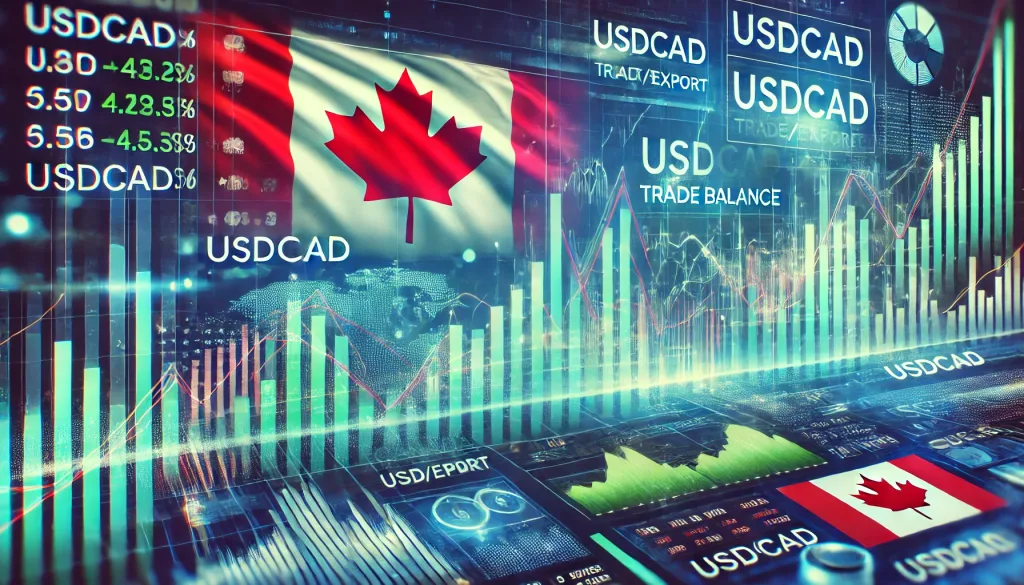The USDCAD Trade Balance Secret: How to Predict Market Moves Like an Insider

The USDCAD pair isn’t just another Forex duo—it’s a market barometer that holds the secrets to North American trade flows, economic shifts, and golden trading opportunities. But most traders focus on surface-level technicals, missing the hidden patterns that institutions use to stay ahead. Today, we’re diving deep into the USDCAD trade balance and uncovering the strategies that can transform how you trade this pair.
Why Trade Balance Matters More Than You Think
The trade balance—the difference between a country’s exports and imports—has a direct impact on a currency’s strength. A trade surplus (more exports than imports) means higher demand for the currency, while a trade deficit weakens it. For USDCAD, understanding Canada’s trade relationship with the U.S. is crucial since the U.S. accounts for over 75% of Canada’s exports.
The Hidden USDCAD Trade Balance Formula:
- Surplus Boom – When Canada exports more oil and raw materials, demand for CAD increases, pushing USDCAD lower.
- Deficit Drag – A weakening trade balance (more imports than exports) means less demand for CAD, sending USDCAD higher.
- Inflation and Rate Reaction – A strong trade balance often leads to a hawkish Bank of Canada (BoC), which can support CAD further.
Little-Known Fact: Canada’s trade balance with the U.S. has historically moved in cycles that align with crude oil prices. Spotting this pattern gives traders an edge in timing their USDCAD trades.
The USDCAD Trade Balance Trading Playbook
1. The Oil Connection: CAD’s Not-So-Secret Best Friend
Canada’s economy is heavily dependent on crude oil exports. This makes the CAD behave like an oil-backed currency. When oil prices rise, Canada earns more from exports, leading to CAD strength and pushing USDCAD down. When oil tanks, USDCAD goes up.
???? How to Trade It:
- Monitor WTI crude oil prices alongside Canada’s trade balance releases.
- If oil rallies before a trade balance surplus report, consider shorting USDCAD.
- If oil collapses and a trade balance deficit is expected, USDCAD longs become attractive.
2. Front-Running Institutional Moves with COT Data
The Commitments of Traders (COT) report reveals how hedge funds and institutional traders position themselves in the market. If large speculators are bullish CAD, they anticipate a stronger trade balance or rising oil prices.
???? How to Trade It:
- Check COT data every Friday to see institutional shifts.
- If large traders are net long CAD and trade balance is improving, consider shorting USDCAD.
- If they’re shorting CAD and trade balance is worsening, go long USDCAD.
Why Most Traders Get It Wrong (And How You Can Avoid It)
Most retail traders ignore economic indicators like the trade balance because they focus only on technical charts. However, institutional traders combine fundamentals with technicals, creating hidden trends that can be exploited.
???? Common Mistakes to Avoid:
- Ignoring the trade balance and blindly trading technical setups.
- Overlooking crude oil’s impact on CAD.
- Not factoring in rate differentials between the Federal Reserve and the Bank of Canada.
Pro Tip: The BoC’s interest rate decisions are often influenced by trade balance shifts. A strong trade balance can lead to rate hikes, while a weak one can mean rate cuts. Stay ahead of these moves.
Game-Changing Strategy: Trade Balance + Interest Rate Divergence
One of the most overlooked strategies in USDCAD trading is the interest rate differential play. When the BoC is tightening policy while the Fed is dovish, CAD strengthens, and USDCAD falls. If the trade balance is also in surplus, the move is even stronger.
???? How to Trade It:
- Track the BoC’s stance and compare it to the Fed.
- Look for positive trade balance surprises aligning with a hawkish BoC.
- Enter a USDCAD short when these factors converge.
Final Thoughts: Mastering the USDCAD Trade Balance Advantage
Mastering the USDCAD trade balance isn’t just about tracking one economic release—it’s about combining fundamental insights, institutional positioning, and technical triggers. By using these hidden techniques, you’ll trade like an insider, spotting opportunities most traders miss.
???? Ready to take your USDCAD trading to the next level?
- Get real-time economic updates at StarseedFX Forex News
- Master next-level strategies with free Forex courses at StarseedFX Education
- Join the StarseedFX Community for expert trade alerts at StarseedFX Community
—————–
Image Credits: Cover image at the top is AI-generated
PLEASE NOTE: This is not trading advice. It is educational content. Markets are influenced by numerous factors, and their reactions can vary each time.

Anne Durrell & Mo
About the Author
Anne Durrell (aka Anne Abouzeid), a former teacher, has a unique talent for transforming complex Forex concepts into something easy, accessible, and even fun. With a blend of humor and in-depth market insight, Anne makes learning about Forex both enlightening and entertaining. She began her trading journey alongside her husband, Mohamed Abouzeid, and they have now been trading full-time for over 12 years.
Anne loves writing and sharing her expertise. For those new to trading, she provides a variety of free forex courses on StarseedFX. If you enjoy the content and want to support her work, consider joining The StarseedFX Community, where you will get daily market insights and trading alerts.
Share This Articles
Recent Articles
The GBP/NZD Magic Trick: How Genetic Algorithms Can Transform Your Forex Strategy
The British Pound-New Zealand Dollar: Genetic Algorithms and the Hidden Forces Shaping Currency Pairs
Chande Momentum Oscillator Hack for AUD/JPY
The Forgotten Momentum Trick That’s Quietly Dominating AUD/JPY Why Most Traders Miss the Signal
Bearish Market Hack HFT Firms Hope You’ll Never Learn
The One Bearish Market Hack High Frequency Traders Don't Want You to Know The

